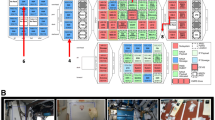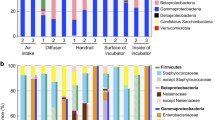Abstract
An evaluation of the microbiota from air, water, and surface samples provided a baseline of microbial characterization onboard the International Space Station (ISS) to gain insight into bacterial and fungal contamination during the initial stages of construction and habitation. Using 16S genetic sequencing and rep-PCR, 63 bacterial strains were isolated for identification and fingerprinted for microbial tracking. Of the bacterial strains that were isolated and fingerprinted, 19 displayed similarity to each other. The use of these molecular tools allowed for the identification of bacteria not previously identified using automated biochemical analysis and provided a clear indication of the source of several ISS contaminants. Strains of Bradyrhizobium and Sphingomonas unable to be identified using sequencing were identified by comparison of rep-PCR DNA fingerprints. Distinct DNA fingerprints for several strains of Methylobacterium provided a clear indication of the source of an ISS water supply contaminant. Fungal and bacterial data acquired during monitoring do not suggest there is a current microbial hazard to the spacecraft, nor does any trend indicate a potential health risk. Previous spacecraft environmental analysis indicated that microbial contamination will increase with time and will require continued surveillance.

Similar content being viewed by others
References
RM Atlas (1993) . Handbook of Microbiological Media, 2nd ed. CRC Press Boca Raton, FL
DA Benson MS Boguski DJ Lipman J Ostell (1997) ArticleTitleGenBank. Nucleic Acids Res 25 1–6 Occurrence Handle10.1093/nar/25.1.1 Occurrence Handle1:CAS:528:DyaK2sXpvVGitg%3D%3D Occurrence Handle9016491
Boyden DG (1962) The bacterial flora in fleet ballistic missile submarines during prolonged submergence. In: U. S. Naval Medical Research Laboratory. Bureau of Medicine and Surgery, Navy Department
HA Burge DL Pierson TO Groves KF Strawn SK Mishra (2000) ArticleTitleDynamics of airborne fungal populations in a large office building. Curr Microbiol 40 10–16 Occurrence Handle10.1007/s002849910003 Occurrence Handle1:CAS:528:DC%2BD3cXhslCl Occurrence Handle10568797
M Drancourt C Bollet A Carlioz R Martelin JP Gayral D Raoult (2000) ArticleTitle16S ribosomal DNA sequence analysis of a large collection of environmental and clinical unidentifiable bacterial isolates. J Clin Microbiol 38 3623–3630 Occurrence Handle1:CAS:528:DC%2BD3cXnsF2nurc%3D Occurrence Handle11015374
JK Ferguson GR Taylor BJ Mieszkuc (1975) Microbiological investigations. RS Johnston LF Deitlein CA Berry (Eds) Biomedical Results of Apollo. Scientific and Technical Information Office, National Aeronautics and Space Administration . 83–103
Y Kawamura Y Li H Liu X Huang Z Li T Ezaki (2001) ArticleTitleBacterial population in Russian space station “Mir.” Microbiol Immunol 45 819–828 Occurrence Handle1:CAS:528:DC%2BD38XhtValsr8%3D Occurrence Handle11838899
Koenig DW, Bell-Robinson DM, Johnson SM, Mishra SK, Sauer RL, Pierson DL (1995) Microbiological analysis in space. 25th International Conference on Environmental Systems, San Diego, CA: SAE Technical Paper Series 951683
DW Koenig DL Pierson (1997) ArticleTitleMicrobiology of the space shuttle water system. Wat Sci Technol 35 59–64 Occurrence Handle10.1016/S0273-1223(97)00235-7 Occurrence Handle1:CAS:528:DyaK2sXmt1KhtLo%3D
HB Levine JM Cobb AB Cobet (1970) ArticleTitleThe Tektite-I dive. Arch Environ Health 20 500–505 Occurrence Handle1:STN:280:CS%2BB3sjpsl0%3D Occurrence Handle4393404
JE Morris (1972) ArticleTitleMicrobiology of the submarine environment. Proc R Soc Med 65 799–800 Occurrence Handle1:STN:280:CSyD3srovVU%3D Occurrence Handle4404406
Mudgett PD, Benoit MJ, Orta DR, Schultz JR (2002) Quality of water supplied by shuttle to ISS. 32nd International Conference on Environmental Systems, San Antonio, TX
DL Pierson (2001) ArticleTitleMicrobial contamination of spacecraft. Grav Space Biol Bull 14 1–6 Occurrence Handle1:STN:280:DC%2BD387jtFartA%3D%3D
DL Pierson CM Ott TO Groves (2002) Characterization of microbial activity in the chamber systems and environment. HW Lane RL Sauer DL Feeback (Eds) Isolation: NASA Experiments in Closed-Environment Living. Univelt San Diego 229–259
RA Samson ES Hoekstra JC Frisvad O Filtenborg (2000) Introduction to Food- and Airborne Fungi, 6th ed. Centraalbureau voor Schimmeelcultures The Netherlands
RA Samson JI Pitt (1989) Modern Concepts in Penicillium and Aspergillus Identification. Plenum Press New York
Samsonov NM, Bobe LS, Gavrilov LI, Korolev VP, Novikov VM, Farafonov NS, Soloukhin VA, Romanov SJ, Andrechuk PO, Protasov NN, Rjabkin AM, Telegin AA, Sinjak JE, Skuratov VM (2002) Water recovery and oxygen generation by electrolysis aboard the International Space Station. 32nd International Conference on Environmental Systems, San Antonio, TX
Stenberg B, Eriksson N, Hansson Mild K, Höög J, Sandström M, Sundell J, Wall S (1993) The Office Illness Project in northern Sweden. An interdisciplinary study of the “sick building-syndrome” (SBS). Indoor Air ‘93 Proceedings. Helsinki, Finland
YW Tang NM Ellis MK Hopkins DH Smith DE Dodge DH Persing (1998) ArticleTitleComparison of phenotypic and genotypic techniques for identification of unusual aerobic pathogenic gram-negative bacilli. J Clin Microbiol 36 3674–3679 Occurrence Handle1:STN:280:DyaK1M%2Fjs1Orsg%3D%3D Occurrence Handle9817894
YW Tang A Von Graevenitz MG Waddington MK Hopkins DH Smith H Li CP Kolbert SO Montgomery DH Persing (2000) ArticleTitleIdentification of coryneform bacterial isolates by ribosomal DNA sequence analysis. J Clin Microbiol 38 1676–1678 Occurrence Handle1:CAS:528:DC%2BD3cXivVelsbk%3D Occurrence Handle10747168
GR Taylor RC Graves RM Brockett JK Ferguson BJ Mieszkuc (1977) Skylab environmental and crew microbiological studies. RS Johnston LF Dietlein (Eds) Biomedical Results from Skylab. Scientific and Technical Information Office, National Aeronautics and Space Administration . 53–63
TL Thomas TI Hooper M Carmaca J Murray D Sack D Molé RT Spiro WG Horn FC Garland (2000) ArticleTitleA method for monitoring the health of U.S. Navy submarine crewmembers during periods of isolation. Aviat Space Environ Med 71 699–705 Occurrence Handle1:STN:280:DC%2BD3M%2FivVeitQ%3D%3D Occurrence Handle10902933
Upsher JF, Fletcher LE, Upsher CM (1994) Microbiological conditions on Oberon submarines. Department of Defence, Defence Science and Technology Organisation, Melbourne, Victoria, Australia
Williams DE, Lewis J, Carrasquillo RL, Reysa R, Gentry G (2002) International Space Station environmental control and life support system status: 2001–2002. 32nd International Conference on Environmental Systems, San Antonio, TX
Acknowledgements
The authors thank Bacterial BarCodes, Inc., for their contribution in the processing and analysis of rep-PCR bacterial fingerprinting. We thank Jane Krauhs of Wyle Laboratories, Inc., for technical editing, and James R. Lupski, M.D., Ph.D., for his review of this manuscript. We also thank the crew of the ISS for sample collection and processing, the ISS Program Office, and the Microbiology Laboratory at the Johnson Space Center. This study was supported by NASA contract NAS9-97005 and NASA grant PWC 111-30-40-97.
Author information
Authors and Affiliations
Corresponding author
Rights and permissions
About this article
Cite this article
Castro, V., Thrasher, A., Healy, M. et al. Microbial Characterization during the Early Habitation of the International Space Station . Microb Ecol 47, 119–126 (2004). https://doi.org/10.1007/s00248-003-1030-y
Received:
Accepted:
Published:
Issue Date:
DOI: https://doi.org/10.1007/s00248-003-1030-y




